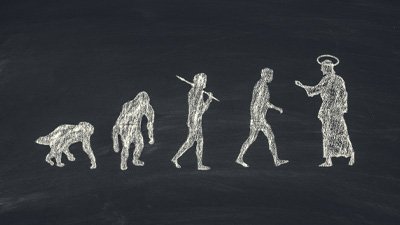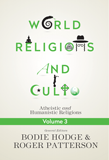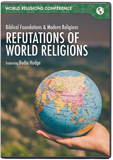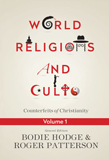Does Monotheism Predate Polytheism?
Contrary to secular theories of the origin of religion, the evidence shows that cultures around the world were originally monotheistic.
It is generally believed by secular cultural anthropologists, as well as many modern philosophy of religion experts, that monotheism arose out of polytheism. This is generally attributed to one of two methods.
Man Looks Outside Himself
The first, which might be labeled as the “man looks outside himself” or natural world model, is based on the presumed attempt by primitive man to rationalize the natural forces at work in the world—the sun, moon, rain, thunder, earth, sky, fire, water, volcanoes, etc.—which led to stories, taking the form of nature myths, that attempted to explain these forces. The terms used in these myths (the word for sun or moon, for example), came to be viewed by primitive peoples as the names of deities, and these gave rise to the pantheons of gods in their cultures.
Man Looks Inside Himself
The earliest pictographs, hieroglyphics, cuneiform, or runic writings of discovered or excavated cultures pointed to an original monotheism which became more and more corrupted into animism or polytheism.
The second view would be considered the “man looks inside himself” or animistic model, which assumes that primitive man used his own existence as a measure of all other existences. Man discerned by introspection that he had a soul, or at least some kind of spiritual inner reality, which he then projected onto all other things and came to think of everything—beasts and plants and eventually even inanimate things and forces of nature—as an intelligent life consisting of body and soul like himself. From this animistic concept, he moved to the view that this spirit world was personal. Thus arose spiritism and/or pantheism. In due time, as society became stratified socially, so did the “spirit” world, until man arrived at a stage of polytheism in which many of the angels and demons were elevated into deities. The final stage was the acknowledgment of one spiritual being who became Chief, i.e., God, and to whom all other angels, demons, and lesser deities were subservient (placing them in a category below godship).
What Does Archaeology Say?
But starting in the early twentieth century, archaeologists began to uncover clues in written records found during excavations and archaeological digs that the exact opposite was true. The earliest pictographs, hieroglyphics, cuneiform, or runic writings of discovered or excavated cultures pointed to an original monotheism which became more and more corrupted into animism or polytheism:
When the cuneiform literature first began to reveal its message, scholars of cuneiform and Egyptian hieroglyphics soon found themselves dealing with a tremendous number of gods and goddesses, and demons and other spiritual powers of a lesser sort, which seemed to be always at war with one another and much of the time highly destructive. As earlier and earlier tablets, however, began to be excavated and brought to light, and skill in deciphering them increased, the first picture of gross polytheism began to be replaced by something more nearly approaching a hierarchy of spiritual beings organized into a kind of court with one Supreme Being over all. One of the first cuneiform scholars to acknowledge the significance of this trend was Stephen Langdon of Oxford, and when he reported his conclusions he did so with a consciousness of the fact that he would scarcely be believed.1
As Langdon himself put it,
I may fail to carry conviction in concluding that both in Sumerian and Semitic religions, monotheism preceded polytheism. . . . The evidence and reasons for this conclusion, so contrary to accepted and current views, have been set down with care and with the perception of adverse criticism. It is, I trust, the conclusion of knowledge and not of audacious preconception.
In my opinion the history of the oldest civilization of man is a rapid decline from monotheism to extreme polytheism and widespread belief in evil spirits. It is in a very true sense the history of the fall of man.2
Then five years after that statement in an article which appeared in The Scotsman, Langdon wrote,
The history of Sumerian religion, which was the most powerful cultural influence in the ancient world, could be traced by means of pictographic inscriptions almost to the earliest religious concepts of man. The evidence points unmistakeably to an original monotheism, the inscriptions and literary remains of the oldest Semitic peoples also indicate a primitive monotheism, and the totemistic origin of Hebrew and other Semitic religions is now entirely discredited.3
Late nineteenth and early twentieth century Bible commentator Friedrich Delitzsch had earlier made a similar proposal regarding the continuing tendency toward the multiplication of gods from a single, original cultural deity. He refers to a tablet reported upon by archaeologist T. G. Pinches which, though only fragmentarily preserved, tells us that all the highest of the deities in the Babylonian pantheon are designated as one with and one in the god Marduk:
The god Marduk is set forth under the name “Ninib,” as “the Possessor of Power”; under the name of “Nergal” or “Zamama,” as “Lord of Battle”; under the name “Bel,” as “Possessor of Lordship”; under the name “Nebo,” as “The Lord the Prophet”; under the name “Sin,” as “Illuminator of the Night”; under the name “Shamash,” as “Lord of all that is Just”; under the name “Addu,” as “God of Rain.” Marduk therefore was Ninib as well as Nergal, Moon-god as well as Sun-god, the names being simply different ways of describing his attributes, powers, or duties.4
Several of these gods were worshipped not only in Babylon but throughout the Middle East, Asia, and Europe. For example, Bel and Marduk (sometimes spelled Merodach) are mentioned in Jeremiah 50:2; Nebo as a Moabite god in Isaiah 15:2 and Jeremiah 48:1, and also as a god worshipped in Israel in Isaiah 46:1. The god Sin was worshipped in Egypt (Ezekiel 30:15–16 NKJV) and Nergal in Babylon (2 Kings 17:30).
The Development of Henotheism and Polytheism from Monotheism
As would be expected from early post-Babel societies which originally knew and (many of which) originally practiced monotheism, as people groups with the seeds of rebellion already in their hearts moved away from each other due to language division, they began to forget (or deliberately suppress) the knowledge of the true God.
Famed British archaeologist Sir Flinders Petrie also mentions this development of the plurality of gods:
Were the conception of a god only an evolution from such spirit worship, we should find the worship of many gods preceding the worship of one god. . . . What we actually find is the contrary of this, monotheism is the first stage traceable in theology. . . . Wherever we can trace back polytheism to its earliest stages, we find that it results from combinations of monotheism. In Egypt even Osiris, Isis, and Horus, so familiar as a triad, are found at first as separate units in different places: Isis as a virgin goddess, and Horus as a self-existent God. Each city appears to have had but one god belonging to it, to whom others were in time added. Similarly Babylonian cities each had their supreme god, and the combinations of these and their transformations in order to form them into groups when their homes were politically united show how essentially they were solitary deities at first.5
German archaeologist and linguist Max Muller argued the same for the Hindu religion:
There is a monotheism that precedes the polytheism of the Veda; and even in the invocation of the innumerable gods the remembrance of a God one and infinite, breaks through the mist of idolatrous phraseology like the blue sky that is hidden by passing clouds.6
Secular and Liberal Biblical Archaeology’s Suppression of the Truth
But most likely, students today will not hear of the above assessments of late nineteenth and early twentieth century archaeologists. Instead, they will be taught by liberal scholars that the Bible is not inerrant but is made up of various regional cultural myths and that monotheism eventually filtered out from polytheism, likely first emerging in Egypt under Akhenaten.7 This concept has not been borne out by more recent archaeology, which still points to an original monotheism, but is promoted—even though it goes against the evidence—by a worldview uncritically accepting conventional Egyptian chronology and deliberately seeking to discredit Scripture.
Biblical Examples of Forgetting God and the Swift Decline into Idolatry and Polytheism
Scripture repeatedly (Deuteronomy 4:23, 6:12, 8:11–19) warns the nation of Israel not to forget the Lord and not to serve other gods (idols); yet they continually did so (1 Kings 16:13, 26; Isaiah 17:10; Jeremiah 3:21, 18:15). It is easy to see that Israel (immediately after they left Egypt) was a monotheistic nation, serving the one true God. Yet just a short time later, we see them falling into idolatry (Exodus 32:1), and later syncretism, which God specifically warned about (Deuteronomy 12:2–4, 30–31).8
Not surprisingly, Scripture accurately portrays the devolution of monotheism into henotheism, then syncretism, and finally polytheism . . .
Not surprisingly, Scripture accurately portrays the devolution of monotheism into henotheism, then syncretism, and finally polytheism, both in Israel and even some surrounding nations like Syria, and compares the henotheistic mindset and practices of Laban in Genesis 31:29–30 with the future polytheistic worship of the Arameans/Syrians in Judges 10:6. Consider also that the book of Jonah implies that the repentance of Nineveh was based on the fact that the king, and presumably some of the people of that city, knew that the gods they worshipped were false or impotent and that the God of Israel was either the one true God or one who was powerful enough to carry out judgement in spite of other weaker ones. Otherwise, why would they care that some other nation’s God said they would be destroyed in forty days?
This descent from the worship of God alone to many gods is often portrayed as swift, within one generation. Moses rehearsed the history of Israel from the Exodus to the end of the wilderness wanderings with a song, recorded in Deuteronomy 31:30–32:44. In the beginning of that section, Moses recounts the depths of the depravity of those Israelites who turned from God to “gods” (demonic entities in actuality—see quote from Deuteronomy below).
I think it fitting in an article discussing polytheism emerging out of monotheism to end on this subsequent passage from Deuteronomy, which if analyzed shows a rapid descent from the knowledge and worship of God to idolatry, animism/demonism, and (as Romans 1 would describe) a complete suppression of the knowledge of God, followed by God “giving them up” to their sins. This is the true history of mankind, not some gradual “upward” progression from primitive animism/polytheism to monotheism but the exact opposite.
The Lord alone guided him,
no foreign god was with him. . . .But Jeshurun grew fat, and kicked;
you grew fat, stout, and sleek;
then he forsook God who made him
and scoffed at the Rock of his salvation.They stirred him to jealousy with strange gods;
with abominations they provoked him to anger.
They sacrificed to demons that were no gods,
to gods they had never known,
to new gods that had come recently,
whom your fathers had never dreaded.
You were unmindful of the Rock that bore you,
and you forgot the God who gave you birth.The Lord saw it and spurned them,
because of the provocation of his sons and his daughters.
And he said, “I will hide my face from them;
I will see what their end will be,
for they are a perverse generation,
children in whom is no faithfulness.” (Deuteronomy 32:12, 15–20)
Footnotes
- Arthur C. Custance, “Evolution or Creation?,” The Doorway Papers, Volume 4 (Grand Rapids, Michigan: Zondervan, 1979), 113–114, https://custance.org/Library/Volume4/Part_II/chapter1.html.
- Stephen H. Langdon, Semitic Mythology, Mythology of All Races, vol. 5 (Boston: Archaeological Institute of America, 1931), 18.
- Stephen H. Langdon, The Scotsman, (November 18, 1936), cited in Custance, “Evolution of Creation?,” 114.
- Friedrich Delitzsch, Babel and Bible (London: Williams and Norgate, 1903), 144.
- Sir Flinders Petrie, The Religion of Ancient Egypt (London: Constable, 1908), 3–4.
- Max Muller, History of Ancient Sanskrit Literature (London: Williams and Norgate, 1860), 559.
- To highlight the standard “pre-Moses” reign of Akhenaten and when historical evidence shows he reigned, see point six of “Doesn’t Egyptian Chronology Prove That the Bible Is Unreliable?”
- Syncretism can be defined as the fusion of diverse religious beliefs and practices into a “new” religion—worshipping God but also Ashtoreth, for example (1 Kings 11:33).
Recommended Resources

Answers in Genesis is an apologetics ministry, dedicated to helping Christians defend their faith and proclaim the good news of Jesus Christ.
- Customer Service 800.778.3390
- © 2024 Answers in Genesis









